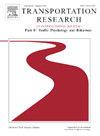融合传感器,将凝视固定与动态驾驶环境联系起来,实现驾驶员注意力管理
IF 3.5
2区 工程技术
Q1 PSYCHOLOGY, APPLIED
Transportation Research Part F-Traffic Psychology and Behaviour
Pub Date : 2024-10-01
DOI:10.1016/j.trf.2024.07.025
引用次数: 0
摘要
背景驾驶环境对于碰撞风险评估非常重要,但对于驾驶环境如何调节开发驾驶员监控系统所需的注意力却知之甚少。方法24名参与者驾驶一辆配备自动驾驶功能的特斯拉Model S行驶在高速公路上,在此期间,驾驶员监控系统、Mobileye和CAN总线对驾驶员的视线、车头、车速和驾驶模式进行了采样。这些信号经过处理后同步到每个单个凝视固定点,并纳入贝叶斯广义线性模型,以评估动态环境因素对单个凝视固定点持续时间的影响。车头距离的变化导致对前车的凝视时间延长。此外,不管是手动驾驶模式还是辅助驾驶模式,车速越高、加减速越大,对道路中心的注视固定时间就越长。此外,驾驶模式本身对凝视持续时间的影响较小。结论传感器融合与计算模型一起解释了真实世界驾驶中驾驶员注意力与动态环境之间的联系:应用:凝视与上下文之间的联系为开发对上下文更敏感的凝视指标提供了启示,从而支持自适应驾驶员注意力管理。本文章由计算机程序翻译,如有差异,请以英文原文为准。
Sensor fusion to connect gaze fixation with dynamic driving context for driver attention management
Objective
The paper aims to integrate interior and exterior sensing signals to explore gaze-context connections for more context-aware driver attention management.
Background
Driving context is important for crash risk assessment, but little is known about how it modulates attention requirements for developing driver monitoring systems.
Method
Twenty-four participants drove a Tesla Model S equipped with Autopilot on the highway, during which driver gaze, headway, speed, and driving mode were sampled from the driver monitoring system, Mobileye, and CAN Bus. These signals were processed and synchronized over each single gaze fixation and incorporated into a Bayesian generalized linear model to assess the effects of dynamic contextual factors on the duration of individual gaze fixation.
Results
During car following, gaze fixations on eccentric locations in the road scene were shorter. Changes in headway led to longer fixations on the lead vehicle. Moreover, higher vehicle speed and larger acceleration/deceleration, regardless of being in the manual or assisted driving mode, led to longer fixations on the road center. In addition, driving mode itself had a small effect on fixation duration.
Conclusion
Sensor fusion, along with computation models, explains the connections between driver attention and dynamic context in real-world driving.
Application: The gaze-context connections provide insight into developing more context-sensitive gaze metrics to support adaptive driver attention management.
求助全文
通过发布文献求助,成功后即可免费获取论文全文。
去求助
来源期刊
CiteScore
7.60
自引率
14.60%
发文量
239
审稿时长
71 days
期刊介绍:
Transportation Research Part F: Traffic Psychology and Behaviour focuses on the behavioural and psychological aspects of traffic and transport. The aim of the journal is to enhance theory development, improve the quality of empirical studies and to stimulate the application of research findings in practice. TRF provides a focus and a means of communication for the considerable amount of research activities that are now being carried out in this field. The journal provides a forum for transportation researchers, psychologists, ergonomists, engineers and policy-makers with an interest in traffic and transport psychology.

 求助内容:
求助内容: 应助结果提醒方式:
应助结果提醒方式:


